2007 HONDA CIVIC HYBRID page 30
[x] Cancel search: page 30Page 22 of 268
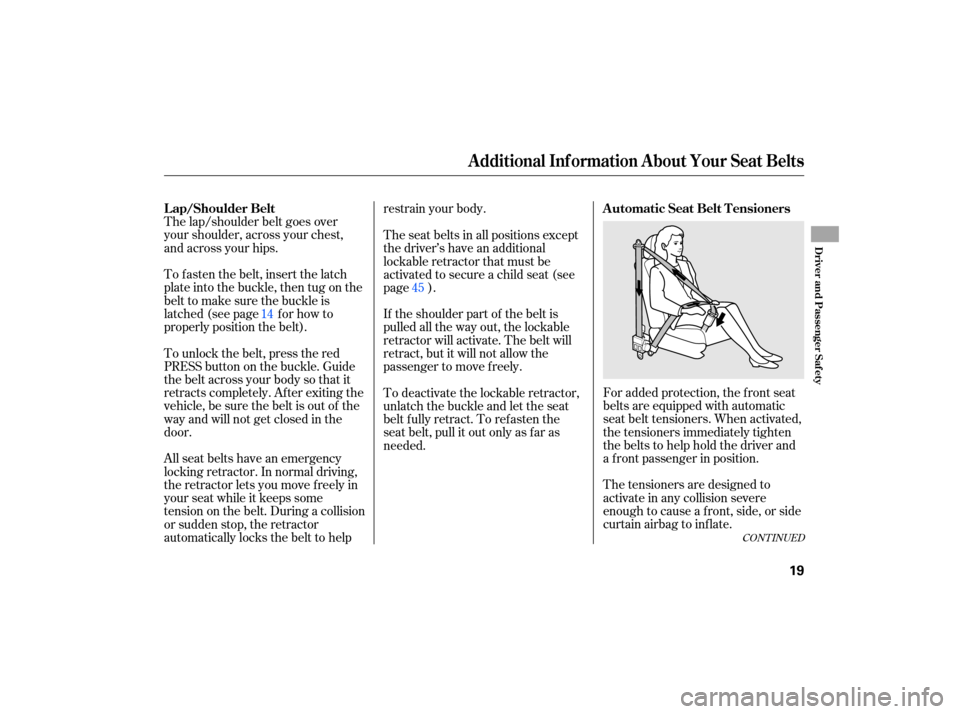
CONTINUED
For added protection, the front seat
belts are equipped with automatic
seat belt tensioners. When activated,
the tensioners immediately tighten
the belts to help hold the driver and
a front passenger in position.
The tensioners are designed to
activate in any collision severe
enough to cause a front, side, or side
curtainairbagtoinflate.
The
lap/shoulder belt goes over
your shoulder, across your chest,
and across your hips.
To fasten the belt, insert the latch
plate into the buckle, then tug on the
belt to make sure the buckle is
latched (see page for how to
properly position the belt).
To unlock the belt, press the red
PRESSbuttononthebuckle.Guide
the belt across your body so that it
retracts completely. After exiting the
vehicle, be sure the belt is out of the
way and will not get closed in the
door.
All seat belts have an emerge ncy
locking retractor. In normal driving,
the retractor lets you move freely in
your seat while it keeps some
tension on the belt. During a collision
or sudden stop, the retractor
automati cally locks the belt to help restrain
your body.
If the shoulder part of the belt is
pulled all the way out, the lockable
retractor will activate. The belt will
retract, but it will not allow the
passenger to move freely.
To deactivate the lockable retractor,
unlatch the buckle and let the seat
belt fully retract. To refasten the
seat belt, pull it out only as far as
needed. The seat belts in all positions except
the driver’s have an additional
lockable retractor that must be
activated to secure a child seat (see
page ).
14 45
Additional Inf ormation About Your Seat Belts
A utomatic Seat Belt T ensioners
L ap/Shoulder Belt
Driver and Passenger Saf ety
19
Page 23 of 268
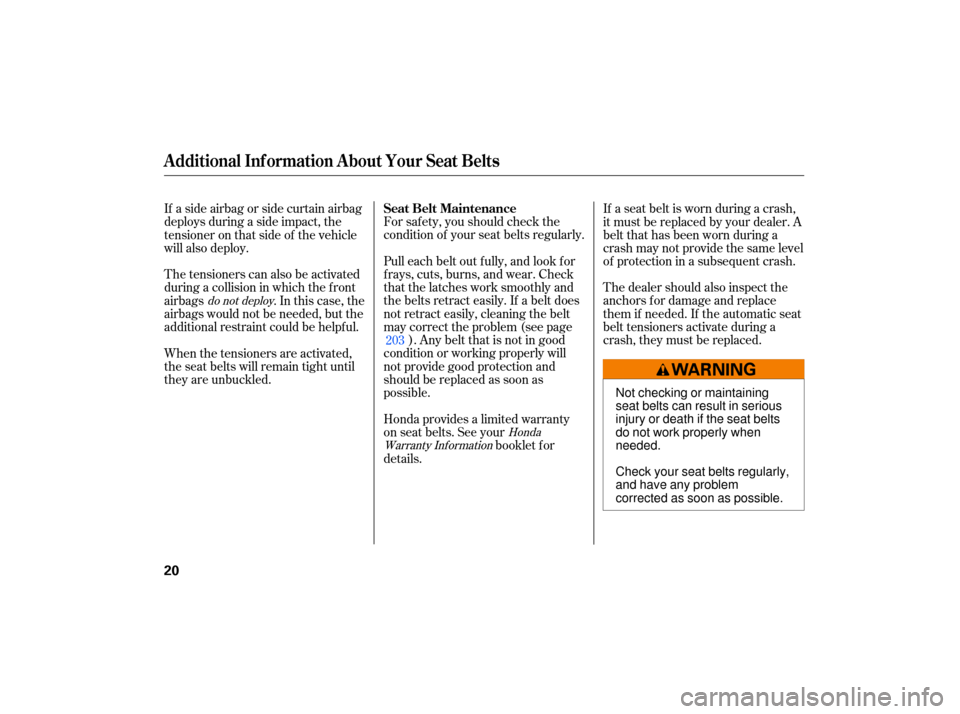
The dealer should also inspect the
anchors for damage and replace
them if needed. If the automatic seat
belt tensioners activate during a
crash, they must be replaced.
For
safety, you should check the
condition of your seat belts regularly.
Pull each belt out fully, and look for
frays, cuts, burns, and wear. Check
that the latches work smoothly and
the belts retract easily. If a belt does
not retract easily, cleaning the belt
may correct the problem (see page ). Any belt that is not in good
condition or working properly will
not provide good protection and
should be replaced as soon as
possible.
The tensioners can also be activated
during a collision in which the f ront
airbags . In this case, the
airbags would not be needed, but the
additional restraint could be helpf ul.
When the tensioners are activated,
the seat belts will remain tight until
they are unbuckled. If a side airbag or side curtain airbag
deploys during a side impact, the
tensioner on that side of the vehicle
will also deploy.
If a seat belt is worn during a crash,
it must be replaced by your dealer. A
belt that has been worn during a
crash may not provide the same level
of protection in a subsequent crash.
Honda provides a limited warranty
on seat belts. See your booklet f or
details. 203
do not deploy
Honda
Warranty Inf ormation
Additional Inf ormation About Your Seat Belts
Seat Belt Maintenance
20
Not checking or maintaining
seat belts can result in serious
injury or death if the seat belts
do not work properly when
needed.
Check your seat belts regularly,
and have any problem
corrected as soon as possible.
Page 25 of 268
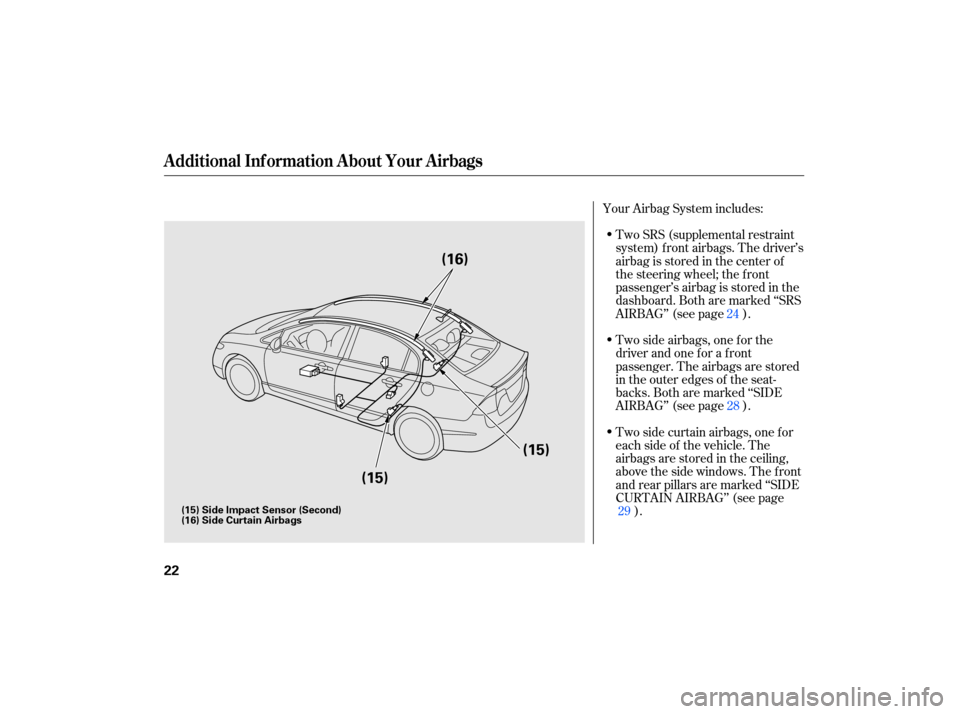
Two SRS (supplemental restraint
system) front airbags. The driver’s
airbag is stored in the center of
the steering wheel; the front
passenger’sairbagisstoredinthe
dashboard. Both are marked ‘‘SRS
AIRBAG’’ (see page ).
Two side airbags, one for the
driver and one for a front
passenger. The airbags are stored
in the outer edges of the seat-
backs. Both are marked ‘‘SIDE
AIRBAG’’ (see page ).
Two side curtain airbags, one for
each side of the vehicle. The
airbags are stored in the ceiling,
above the side windows. The front
and rear pillars are marked ‘‘SIDE
CURTAIN AIRBAG’’ (see page ).
Your Airbag System includes:
2428
29
Additional Inf ormation About Your Airbags
22
(16)
(15)
(15)
(15) Side Impact Sensor (Second)
(16) Side Curtain Airbags
Page 26 of 268

Sensors that can detect a
moderate to severe front impact or
side impact. An
indicator on the instrument
panel that alerts you that the
passenger’s side airbag has been
turned off (see page ).
An indicator on the dashboard that
alerts you that the passenger’s
front airbag has been turned off
(see page ).
Emergency backup power in case
your vehicle’s electrical system is
disconnected in a crash.
Automatic
front seat belt
tensioners (see page ).
Sensors that can detect whether
a small person or child is in the
passenger’s side airbag path and
signal the control unit to turn
the airbag off (see page ).
A driver’s seat position sensor that
monitors the distance of the seat
from the front airbag. If the seat is
too far forward, the airbag will
inflate with less force (see page
).
Sensors
that can detect whether
the driver’s seat belt and a front
passenger’s seat belt is latched
or unlatched (see page ). Sensors
that monitor the weight
on the front passenger’s seat. If
the weight is about 65 lbs (29
kg) or less (the weight of an
infant or sm all child), the
passenger’s front airbag will be
turned off (see page ).
An indicator on the instrument
panel that alerts you to a possible
problem with your airbags,
sensors, or seat belt tensioners
(see page ).
A sophisticated electronic system
that continually monitors and
records inf ormation about the
sensors, the control unit, the
airbag activators, the seat belt
tensioners, and driver and f ront
passenger seat belt use when the
ignition switch is in the ON (II)
position.
19
31
18
26 30 30
31
26
Additional Inf ormation About Your Airbags
Driver and Passenger Saf ety
23
Page 27 of 268
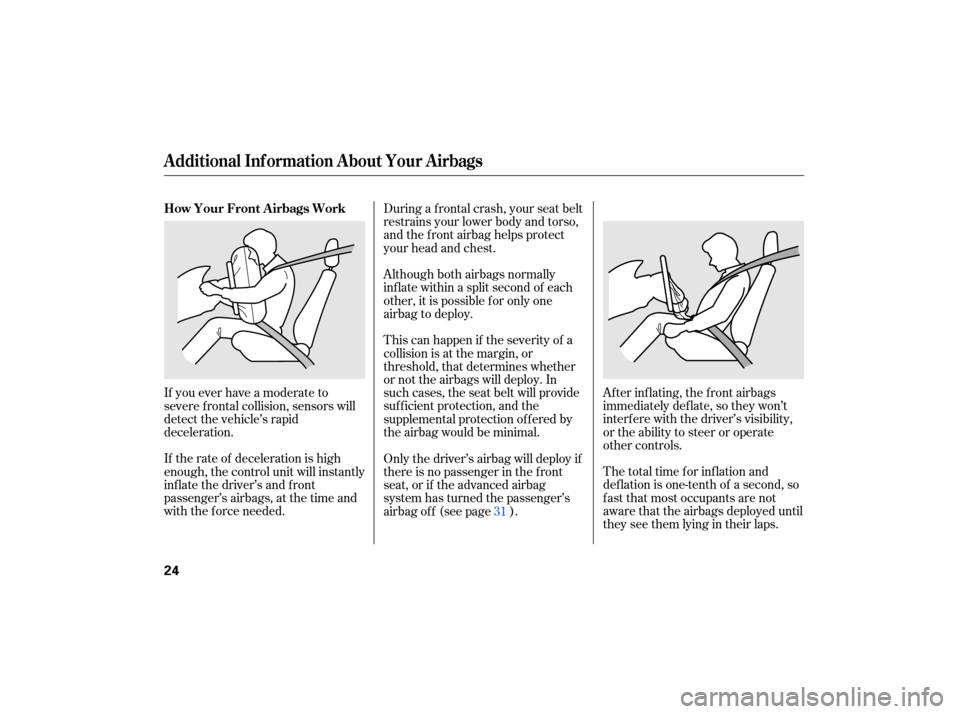
The total time for inflation and
deflation is one-tenth of a second, so
fast that most occupants are not
aware that the airbags deployed until
they see them lying in their laps.
After
inflating, the front airbags
immediately deflate, so they won’t
interfere with the driver’s visibility,
or the ability to steer or operate
other controls.
Du
ring a frontal crash, your seat belt
restrains your lower body and torso,
and the front airbag helps protect
your head and chest.
Al though both airbags normally
inflate within a split second of each
other, it is possible for only one
airbag to deploy.
This can happen if the severity of a
collision is at the margin, or
threshold, that determines whether
or not the airbags will deploy. In
such cases, the seat belt will provide
sufficient protection, and the
supplemental protection offered by
the airbag would be minimal.
If
you ever have a moderate to
severe frontal collision, sensors will
detect the vehicle’s rapid
deceleration.
If the rate of deceleration is high
enough, the control unit will instantly
infl ate the driver’s and front
passenger’s airbags, at the time and
with the f orce needed. Only the driver’s airbag will deploy if
there is no passenger in the f ront
seat, or if the advanced airbag
system has turned the passenger’s
airbag off (see page ).
31
How Your Front Airbags Work
Additional Inf ormation About Your Airbags
24
Page 30 of 268
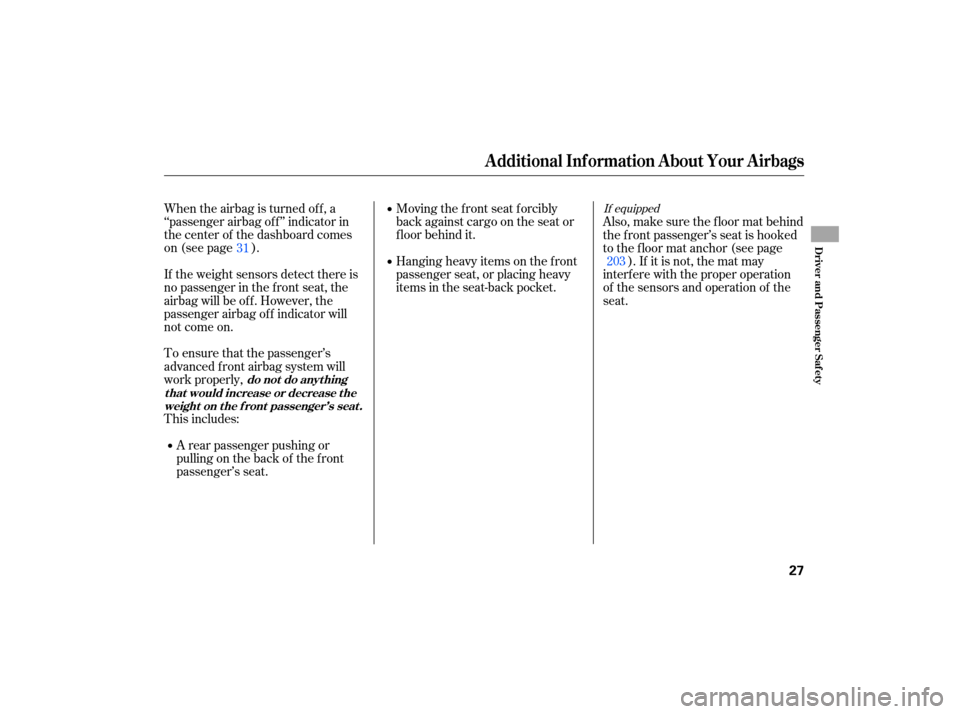
When the airbag is turned off, a
‘‘passenger airbag off’’ indicator in
the center of the dashboard comes
on (see page ). Moving
the front seat forcibly
back against cargo on the seat or
floor behind it.
Hanging heavy items on the front
passenger seat, or placing heavy
items in the seat-back pocket.
To ensure that the passenger’s
advanced front airbag system will
work properly,
This includes:
A rear passenger pushing or
pulling on the back of the front
passenger’s seat.
If
the weight sensors detect there is
no passenger in the front seat, the
airbag will be off. However, the
passenger airbag off indicator will
not come on. Also,makesurethefloormatbehind
the f ront passenger’s seat is hooked
to the floor mat anchor (see page
). If it is not, the mat may
interf ere with the proper operation
of the sensors and operation of the
seat.
31
203If equipped
Additional Inf ormation About Your Airbags
do not do anyt hing
t hat would increase or decrease t he weight on the f ront passenger’s seat.
Driver and Passenger Saf ety
27
Page 32 of 268
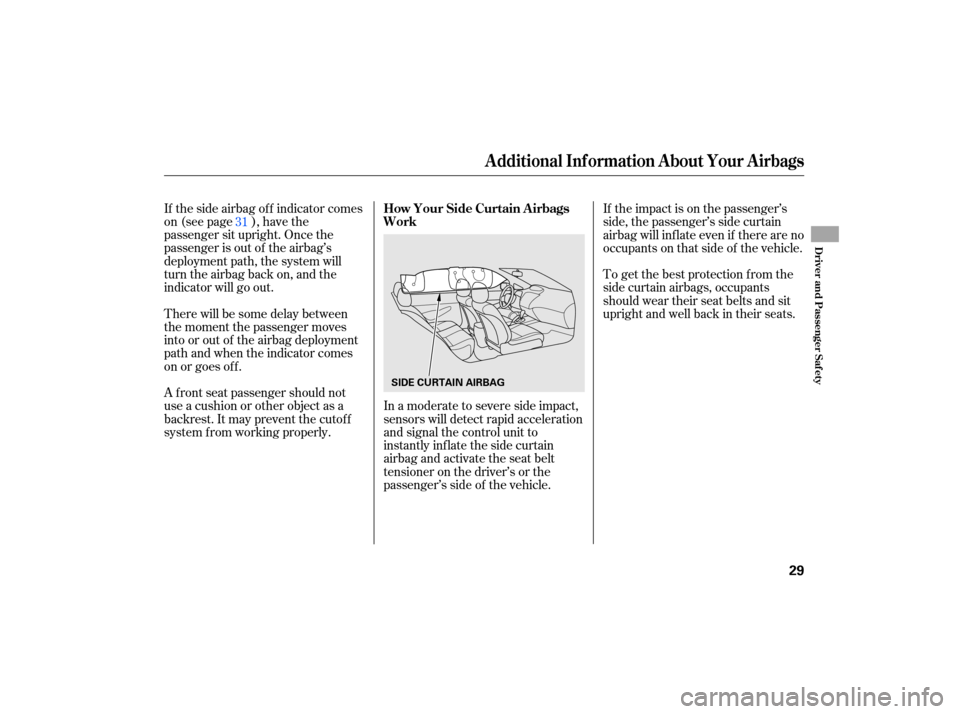
If the side airbag off indicator comes
on (see page ), have the
passenger sit upright. Once the
passenger is out of the airbag’s
deployment path, the system will
turn the airbag back on, and the
indicator will go out.
There will be some delay between
the moment the passenger moves
into or out of the airbag deployment
pathandwhentheindicatorcomes
on or goes of f .
A f ront seat passenger should not
use a cushion or other object as a
backrest. It may prevent the cutof f
system f rom working properly. If the impact is on the passenger’s
side, the passenger’s side curtain
airbag will inflate even if there are no
occupants on that side of the vehicle.
To get the best protection f rom the
side curtain airbags, occupants
should wear their seat belts and sit
upright and well back in their seats.
In a moderate to severe side impact,
sensors will detect rapid acceleration
and signal the control unit to
instantly inflate the side curtain
airbag and activate the seat belt
tensioner on the driver’s or the
passenger’s side of the vehicle.
31
Additional Inf ormation About Your Airbags
How Your Side Curtain A irbags
Work
Driver and Passenger Saf ety
29
SIDE CURTAIN AIRBAG
Page 33 of 268
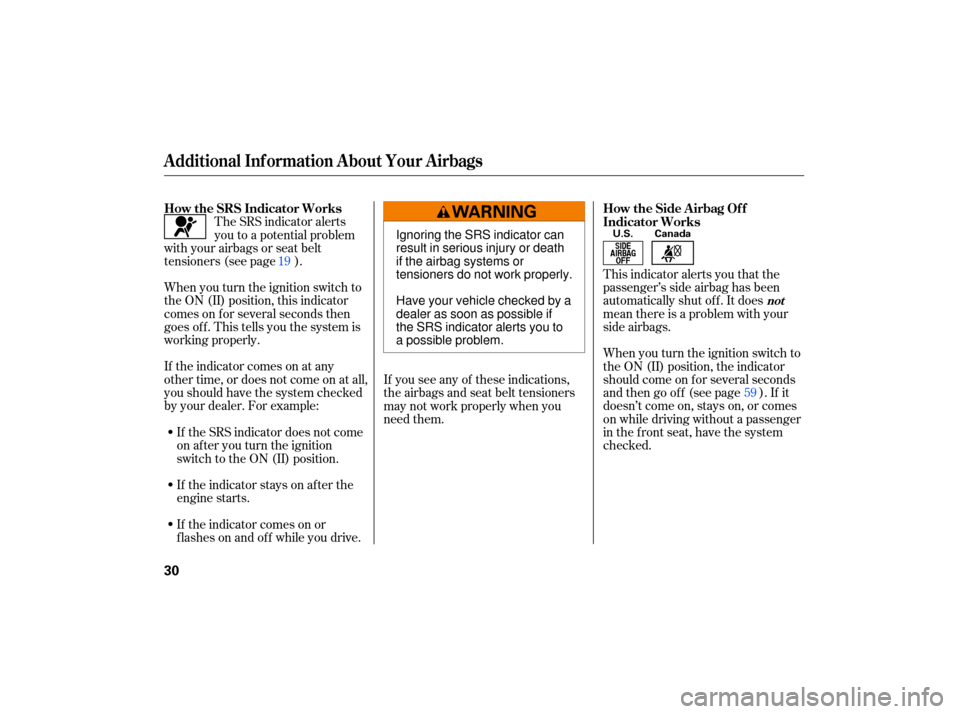
If the indicator comes on at any
other time, or does not come on at all,
you should have the system checked
by your dealer. For example: This
indicator alerts you that the
passenger’s side airbag has been
automatically shut off. It does
mean there is a problem with your
side airbags.
Wh
en you turn the ignition switch to
the ON (II) position, this indicator
comes on for several seconds then
goes off. This tells you the system is
working properly.
When you turn the ignition switch to
the ON (II) position, the indicator
should come on for several seconds
andthengooff(seepage ).Ifit
doesn’t come on, stays on, or comes
on while driving without a passenger
in the front seat, have the system
checked.
If
you see any of these indications,
the airbags and seat belt tensioners
may not work properly when you
need them.
The
SRS indicator alerts
you to a poten tial problem
with your airbags or seat belt
tensioners (see page ).
If the indicator comes on or
flashesonandoff whileyoudrive. If the indicator stays on after the
engine starts. If the SRS indicator does not come
on after you turn the ignition
switch to the ON (II) position. 59
19
How the SRS Indicator Works How the Side A irbag Of f
Indicator Works
Additional Inf ormation About Your Airbags
not
30
U.S. CanadaIgnoring the SRS indicator can
result in serious injury or death
if the airbag systems or
tensioners do not work properly.
Have your vehicle checked by a
dealer as soon as possible if
the SRS indicator alerts you to
a possible problem.